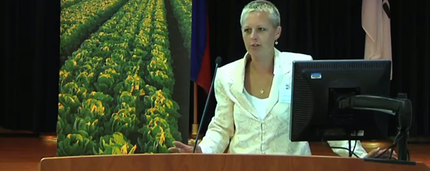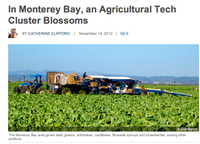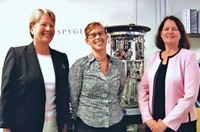In the spirit of highlighting innovative technology solutions that could be of use to the agricultural sector of the Monterey Bay Region, Project 17 has initiated "Ag-Innovation Corner."
These briefings (2-hour sessions) are meant to complement the Project 17 Think Tank Session series by highlighting individual companies and solutions throughout the year. These are small briefings designed to learn about the technology and allow time for questions and discussion.
Solsustech, January 27th, 2012

Deb Walliser is the founder and director of Solsustech, Inc.
The first technology to be showcased was Solsustech, Inc., a hydroponics-focused company.
Invitees to this AG Innovation Corner included growers, chefs, and those in the produce industry both public and private sectors. Several participants had tasted, seen and/or bought products from Solsustech’s greenhouse in Arizona. Ms. Walliser has been developing her own out-of-the-box thinking for hydroponics for more than 12 years. She addressed issues of efficiency, air and water quality and fresh food production and food distribution.
As the director of Solsustech, Ms. Wallister is interested in attracting investment in the company as well as engaging with local farms interested in cost-effective growing techniques and technology. For further information about Solsustech, including pictures of crops and greenhouses grown and built, please visit www.solsustech.com and click on the photos link.
CORNER NOTES
The hydroponic growing system Ms. Walliser developed from her work at NASA employs an Internet-controlled approach to the use of hydroponic technology in growing quality lettuce in a third of the time of growing in the ground and on 1 gallon of water per head. She shared the following key points with our group, which included representatives from Taylor Farms, Earthbound Farms, and the Monterey County Farm Bureau:
· One acre of the hydroponic greenhouse produces 1 million heads of lettuce (vs. 50,000 heads/acres from a soil-based farm) at about 7-10 cents/head (vs. 22 cents/head for traditional growing and shipping practices). This assumes “growing locally,” a benefit of the system, and the greenhouse is located near customers.
· It costs $1 million to build a one-acre Solsustech greenhouse, and it will last about 15 years before the poly carbonate walls need to be replaced.
· One can plant a number of varieties (of plants) on one hydroponic pond and can harvest daily.
· If servicing a local clientele, cost savings accrue from not having to process in a cooler or transport long distances.
· There is no need to wash the plants as there are no pathogens that can enter the enclosed system where they are grown.
Those in the AG Innovation Corner had many interesting questions about the functioning of these hydroponic greenhouses. We share here the key questions posed by participants.
Q. Does the length of day have any impact on the growth of plants in the hydroponic pond?
A. Yes: light does play a role
Q. How is the greenhouse heated?
A. The thermal properties of water are used to reduce heating and cooling costs. Additional heat is generated from propane or natural gas heaters.
Q. What is the design of the greenhouse (i.e., what are the specs)?
A. It is manufactured from Deb Walliser’s specifications using off-the-shelf materials. The poly material that makes up the walls of the greenhouse lasts 15 years. Consider the durability of this material versus the breakability of glass windows.
Q. How do you figure out the quantity and size of ponds within one greenhouse?
A. It depends on the needs of the growers. One may plant multiple varieties within one pond.
Q. How hard is it to scale up for commercial production?
A. Currently it costs 22-25 cents/head to produce and harvest, process and transport lettuce in Salinas in the ground versus 7-10 cents/head through locally grown hydroponics. When calculating the differences in costs, one needs to figure in transportation costs; refrigeration; cost savings in not being exposed to pathogens; etc. (Will this system impact costs of insuring against recalls and deaths? Or is that covered by the Feds crop insurance program?)
Q. How is the water in the greenhouse managed? Is there run-off?
A. There is a custom-mixed fertilizer based upon the local source of water. The water is contained and can either go on to the field after its usage; or be amended and re-used in the greenhouse.
For further information about Solsustech, including pictures of crops and greenhouses grown and built, please visit www.solsustech.com.
For information about Project 17’s , please contact Dr. Susan J. Duggan, Strategist, Project 17, at duggan@smartworldcenter.com.




